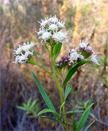Baccharis salicifolia is a blooming shrub native to the sage scrub community and desert southwest of the United States and northern Mexico, as well as parts of South America. Its usual common name is mule fat; it is also called mule’s fat, seepwillow or water-wally.
The common name mule’s fat is a reflection of the consideration that mules would bloat after eating the plant.
An erect, woody, willowlike perennial shrub growing to 12 inches high with stems that are simple to branched and glabrous to minutely puberulent, often sticky, and branches that are longitudinally grooved, Baccharis Salicifolia bears plentiful small, fuzzy, pink or red-tinged white flowers which are highly attractive to butterflies. The long pointed leaves may be toothed and contain three lengthwise veins. It is most common near water sources, but is occasionally found in non-wetlands, according to the U.S. Fish & Wildlife Service.
The bushy and sticky-foliaged Mulefat’s leaves are alternate and lance linear, as well as acuminate-tipped, with the midrib more prominent than the lateral veins. The leaves can be up to six inches long and are on short petioles. The flower heads are disciform and are arranged in compact terminal clusters at the ends of the branches. Baccharis is a dioecious genus, so there are both staminate, i.e., male, and pistillate, female, heads to these plants, but they are always on separate plants. The involucres of both are hemispheric, white, and roughly 3/16 of an inch high, with imbricated phyllaries in 4-5 series, ovate to lanceolate in shape, somewhat papery or scarious in texture, glabrous and tinged red or pink.
Mulefat is mostly found below 3,500 feet in altitude, along stream banks and in dry stream beds in coastal sage scrub and chaparral. It ranges from Baja to central California and from the coast to the deserts, and blooms most of the year but principally from April to October. It used to be named B. glutinosa, referring to the glutinous character of the leaves, but in the more recent Jepson Manual it is listed as B. salicifolia, meaning it is willow-like in appearance.
The Indians made spears from the wood and hardened it by putting it in fire after stripping the bark. Kumeyaay, Maricopa and Mojave Indians made a box trap for quail from elderberry, mulefat or arroweed sticks. According to some accounts, on occasion so many quail became trapped under the box that they flew away with it.
Mulefat is treasured for its medicinal effect. The leaves were used as an eyewash and to cure baldness by some Indian tribes. The Kayenta Navajo people used the plant in a compound infusion of plants used as a lotion to counteract chills.
SBCSentinel
News of note from around the largest county in the lower 48 states.

